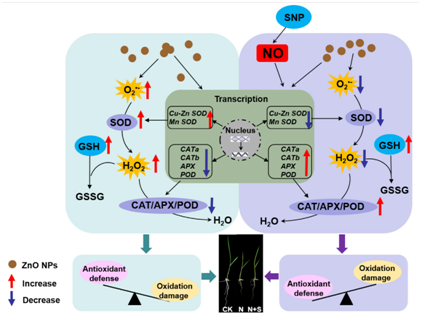作 者:Chen, J., Liu, X., Wang, C., Yin, S.S., Li,X.L., Hu, W.J., Simon, M., Shen, Z.J., Xiao, Q., Chu, C.C., et al. 影响因子:4.565
刊物名称:Journal of Hazardous Materials
出版年份:2015
卷:297 页:173-182
Nitric oxide (NO) has been found to function in enhancing plant tolerance to various environmentalstresses. However, role of NO in relieving zinc oxide nanoparticles (ZnO NPs)-induced phytotoxicityremains unknown. Here, sodium nitroprusside (SNP, a NO donor) was used to investigate the possibleroles and the regulatory mechanisms of NO in counteracting ZnO NPs toxicity in rice seedlings. Ourresults showed that 10 μM SNP significantly inhibited the appearance of ZnO NP toxicity symptoms. SNP addition significantly reduced Zn accumulation, reactive oxygen species production and lipid peroxidation caused by ZnO NPs. The protective role of SNP in reducing ZnO NPs-induced oxidative damageis closely related to NO-mediated antioxidant system. A decrease in superoxide dismutase activity, as well as an increase in reduced glutathione content and peroxidase, catalase and ascorbate peroxidase activity was observed under SNP and ZnO NPs combined treatments, compared to ZnO NPs treatment alone. The relative transcript abundance of corresponding antioxidant genes exhibited a similar change. The role of NO in enhancing ZnO NPs tolerance was further confirmed by genetic analysis using a NO excess mutant (noe1) and anOsNOA1-silenced plant (noa1) of rice. Together, this study provides the first evidence indicating that NO functions in ameliorating ZnO NPs-induced phytotoxicity.

Fig.8.Proposed model for the role of NO in alleviating ZnO NPs-induced oxidative damage in rice seedlings. Increased component is marked by an upward arrow and red color, decreased component is marked by a downward arrow and blue color. CK, the control; N, ZnO NPs treatment alone; N + S, ZnO NPs + SNP treatment. (For interpretation of the references to color in this figure legend, the reader is referred to the web version of this article.)

